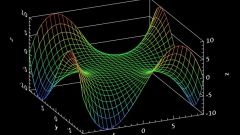Instruction
1
2
Remark. Partial derivatives of the function z=f(x, y) may not exist at the point of extremum, so the points of extremum are not only stationary points, but the points at which partial derivatives do not exist (they correspond to the edge surface of the graphics function).
3
Now you can go to sufficient conditions for the existence of the extremum. If a differentiable function has an extremum, then it can only be at a stationary point. Sufficient conditions are formulated as follows: suppose that in some neighborhood of the stationary point (x0, y0) the function f(x, y) has continuous partial derivatives of second order. For example: (cm. Fig.2)
4
Then: a) if Q>0, the point (x0, y0) the function has an extremum, with f’(x0, y0)0) - local minimum; b) if Q
5
For finding the extremum of functions of two variables can suggest the following scheme: first, are the stationary points of the function. Then these points are checked sufficient conditions. If the function in some points does not have partial derivatives in these points also can be an extremum, but sufficient conditions are no longer applicable.
6
7
8
Since Q(0, 0)0, consequently, at the point (1/3, 1/3) is the extremum. Given the fact that the second derivative (xx) to (1/3, 1/3) is greater than zero, you must make a decision that this point is a minimum.





